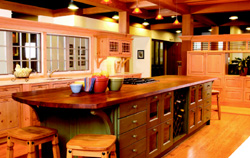To help the Hines sales force realize both the complexities of the new business and the revenue opportunities it could provide, Timmer says the firm went on a “full-court press” in the first half of 2005 to make sure members of its sales force—from regional sales managers to lumber-focused agents working in Hines’ 12 yards throughout the Chicagoland area—were totally on board with the more involved order process. He estimates that the push has boosted the facility’s customer base by at least 25 percent. “When a company absorbs a new facility, it takes time to bring the entire sales force up to speed,” Timmer says. “A year ago, there were only four Hines salespeople outside of this location selling the custom mill-work product. Now, we have over 20, so we’re getting a lot of traction within the sales organization as a whole.”
That traction is coming from customers like Dave Knecht, president and owner of Hinsdale, Ill.–based Northridge Builders, who looks to Hines to provide that wow factor in the $2 million to $12 million homes his firm builds. “If we’re doing a Georgian-style home, that thing is going to be loaded with paneling, custom moldings, and big columns. Then, we’re going to have a lot of custom doors, base casing, paneling, and ceiling treatments,” says Knecht, a Hines customer for 14 years who builds about 10 homes a year. “We may spend $300,000 to $400,000 just on a mill-work package inside the house.”
Crossing Over In addition to millwork packages approaching half a million dollars, Hines salespeople who have embraced the new business have found success cross-selling the firm’s traditional products, as well. “We’ve been very successful offering multiple-product discounts,” says Edward Campbell Jr., a regional sales manager for Hines. “When someone orders from the custom millwork facility, or from Hines Lumber, we put together a presentation showing all the products we have to offer across the company, and then offer them that discount if they buy across multiple product categories.”
That cross-sell has created one-stop customer service synergies at the firm that weren’t in place before. “Our yard salespeople are selling a lot of custom millwork products and, conversely, Hines is picking up a lot of building material customers from the client base at Muench,” Timmer says. “Now they know they can get their custom millwork and get connected on their lumber, building products, and trusses, too.”
For Knecht, Hines provides a type of one-stop shopping he says is rare at other yards. “I don’t think anybody has the one-two punch that Hines does,” Knecht says. “You can keep everything under one hat.”
From a technology standpoint, Hines had to bring the custom facility into its corporate fold, as well. Shortly after it acquired Muench, Hines started implementing Activant Solutions’ Falcon enterprise management software company-wide, but it was unsure how that technology would be adopted at the custom millwork facility, where work and purchase orders for parts on custom orders had previously been written on paper. They needn’t have worried: Because of the custom facility’s inherently complex production requirements, order-takers at the plant actually tapped into the software to unlock its ordering and inventory tracking capabilities that could also be adopted company-wide.
“They dug through Falcon and found some of these inventory management solutions that we candidly didn’t now about,” Hines says. “Because of the discipline needed to manage [their] stock that’s coming weeks in the future, sometimes from different continents, they were able to find some hidden capabilities that have allowed us to make quantum improvements in our inventory management company-wide. So, a $10 million operation fundamentally altered the way we view the $260 million whole. They went from being the implementation that we were worried about to the implementation that we pointed to as an example of a best practice.”
The implementation has made a difference for customers, as well. A Muench customer even before Hines acquired the plant, Knecht has noticed a positive difference since Hines integrated the unit into its own business. “I was dealing with Muench for a long time,” Knecht says. “But I will say, the production, the invoicing, and the attention we’re getting now that Hines is in there is better than it’s ever been.”
—Joe Bousquin is a contributing editor for PROSALES.


